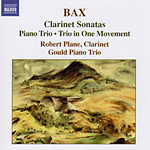The works on this collection cover pretty much the entire span of Bax’s composing career. The Clarinet Sonata in E and the Romance are among Bax’s earliest (around 1901) published compositions, and both display the strong influence of Brahms. Five years later came the one-movement Trio where Bax’s emerging style had by now expanded to reflect his immersion in the music of Scriabin and Debussy. Even so, there are many hints of the composer’s mature style in this rhapsodic work, which originally was scored for piano, violin, and viola. Bax’s well-considered revision provides ample opportunities for clarinetist Robert Plane, who takes to the part with discernible relish, playing with gorgeous tone and rhythmic acuity throughout–just as he does in the earlier Sonata and Romance.
The D major Clarinet Sonata (1934) is a work of Bax’s full maturity, easily recognizable by its distinctive harmonic language, rhythmic sense, and frequently winsome mood–this last which Plane captures perfectly in his free-flowing rendition. The mood turns elegiac for the Folk-Tale, which features beautiful and quite moving writing for cello and piano, masterfully conveyed by Alice Neary and Benjamin Frith. Finally, Bax’s 1945 Piano Trio in B-flat proved to be his last chamber work. This is now the composer we know from the symphonies–indeed, the first movement, with its persistent jig-rhythm and fast-slow-fast formal plan has much in common with Bax’s Symphony No. 4. It’s a marvelous work that relaxes for a languorous middle movement, then perks up again with a stimulating 5/8 finale. The Gould Piano Trio’s superlative performance crowns this most enjoyable disc, which includes the added benefit of excellent recorded sound. Bax fans, this one’s for you. [7/14/2006]
































